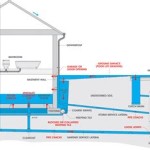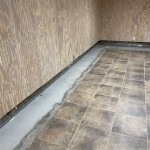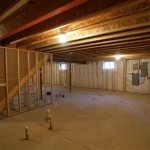How Much Insulation Do I Need For My Basement Ceiling?
Determining the appropriate amount of insulation for a basement ceiling is a multifaceted process. Several factors influence the optimal R-value, a measure of thermal resistance, required to effectively insulate the space. These factors include the local climate, the intended use of the basement, and existing structural conditions. Insufficient insulation can lead to uncomfortable temperatures, increased energy consumption, and potential moisture problems. Conversely, over-insulating may not provide a significant return on investment and could, in some cases, exacerbate moisture issues if not properly installed.
The primary goal of insulating a basement ceiling is to regulate temperature fluctuations, reducing heat loss during colder months and keeping the space cooler during warmer months. This regulation translates to energy savings by reducing the load on heating and cooling systems. Furthermore, insulation contributes to soundproofing, minimizing noise transmission between the basement and the floors above. Selecting the correct insulation type and R-value is, therefore, a crucial aspect of home improvement.
Understanding insulation R-values is paramount to making informed decisions. R-value represents the insulation's ability to resist heat flow. The higher the R-value, the greater the insulating power. Different insulation materials offer varying R-values per inch of thickness. For instance, fiberglass batts, a common insulation choice, typically offer an R-value of around 3.0 to 4.0 per inch, while spray foam insulation can achieve R-values exceeding 6.0 per inch. The recommended R-value for a basement ceiling varies by climate zone, as dictated by building codes and energy efficiency guidelines.
Building codes often stipulate minimum R-value requirements for different areas of a home, including basement ceilings. These codes are designed to ensure energy efficiency and occupant comfort. Local building departments can provide specific information on the required R-values for a particular geographic location. Adhering to these codes is essential for compliance and can also affect property value. Failure to meet code requirements can result in fines or the need for corrective action.
Several insulation types are commonly used for basement ceilings, each with its own advantages and disadvantages. Fiberglass batts and rolls are relatively inexpensive and easy to install, making them a popular choice for DIY projects. However, they can be less effective at filling gaps and preventing air leaks. Spray foam insulation, both open-cell and closed-cell varieties, offers superior air sealing and higher R-values per inch. However, it is typically more expensive and requires professional installation. Rigid foam boards, such as expanded polystyrene (EPS) and extruded polystyrene (XPS), provide good insulation and moisture resistance but can be more challenging to install correctly in confined spaces.
Climate Considerations and Recommended R-Values
The climate in which a home is located significantly impacts the amount of insulation required for the basement ceiling. The United States is divided into climate zones, each with different heating and cooling needs. Colder climates, characterized by long, harsh winters, necessitate higher R-values to minimize heat loss and reduce heating costs. Warmer climates, on the other hand, may require lower R-values to prevent overheating and minimize cooling costs. Mixed climates, with moderate winters and summers, fall somewhere in between.
In colder climate zones (Zones 5 and higher), a basement ceiling insulation R-value of R-30 or higher is generally recommended. This level of insulation helps to maintain a comfortable temperature in the basement and reduces energy consumption. In moderate climate zones (Zones 3 and 4), an R-value of R-19 to R-25 may be sufficient. In warmer climate zones (Zones 1 and 2), an R-value of R-13 to R-19 might be adequate. These are generalized recommendations, and it's always best to consult local building codes and energy efficiency guidelines for specific requirements.
The U.S. Department of Energy provides detailed maps and resources outlining climate zones and recommended insulation levels. These resources can be valuable in determining the appropriate R-value for a specific location. Furthermore, energy audits conducted by qualified professionals can provide tailored recommendations based on a home's specific characteristics and energy usage patterns.
Factors Influencing Insulation Requirements Beyond Climate
While climate is a primary determinant, other factors also influence the required insulation level. These include the intended use of the basement, the presence of moisture issues, and the existing construction materials and methods. For instance, a basement that is used as a living space, such as a bedroom or recreation room, will require more insulation than a basement that is primarily used for storage or mechanical equipment.
If the basement is prone to moisture issues, such as dampness or condensation, it is crucial to address these issues before installing insulation. Moisture can degrade insulation performance and lead to mold growth, which can pose health risks. Waterproofing the basement walls and floor, as well as improving ventilation, can help to mitigate moisture problems. Selecting moisture-resistant insulation materials, such as closed-cell spray foam or rigid foam boards, can also be beneficial in damp environments.
The type of construction materials used in the basement ceiling can also affect insulation requirements. Concrete ceilings, for example, tend to be colder than wood-framed ceilings and may require more insulation. The presence of existing insulation can also influence the amount of additional insulation needed. It is important to assess the existing insulation's R-value and condition before adding more. Combining different types of insulation can be effective, but it is essential to ensure that they are compatible and installed correctly to avoid condensation issues.
Installation Techniques and Considerations
Proper installation is just as important as selecting the correct insulation type and R-value. Even the best insulation will perform poorly if it is not installed correctly. Gaps and air leaks can significantly reduce the effectiveness of insulation, allowing heat to escape and cold air to enter. Therefore, it is crucial to seal all cracks and openings before installing insulation.
When installing fiberglass batts or rolls, ensure that they fit snugly between the ceiling joists and are not compressed. Compressed insulation loses its R-value. Use a sharp utility knife to cut the insulation to the correct size and shape. Wear appropriate safety gear, including gloves, a dust mask, and eye protection, when handling fiberglass insulation. Consider using a kraft-faced insulation, which has a paper facing that acts as a vapor retarder. However, in some climates, a separate vapor retarder may be necessary.
Spray foam insulation requires professional installation due to the specialized equipment and expertise required. Closed-cell spray foam offers superior air sealing and moisture resistance, but it is more expensive than open-cell spray foam. Open-cell spray foam is less expensive but may not provide as much moisture resistance. When installing rigid foam boards, ensure that they are tightly fitted together and sealed with tape to prevent air leaks. Fasten the foam boards to the ceiling joists using appropriate fasteners.
Proper ventilation is also essential for maintaining a healthy and comfortable basement. Insulating the ceiling can reduce natural ventilation, so it may be necessary to install mechanical ventilation to ensure adequate airflow. Dehumidifiers can also help to control moisture levels in the basement. Regularly inspect the insulation for signs of moisture damage or mold growth. Address any issues promptly to prevent further damage and maintain indoor air quality.

What Is Basement Ceiling Insulation And It Worth

Should I Insulate My Basement Ceiling And Walls Aire Serv

What Are The Pros And Cons Of Basement Ceiling Insulation Upgradedhome Com

Best Insulation For Soundproofing Your Ceiling Renoviso

Ceiling Insulation In Your Basement

Basement Ceiling Insulation Interior Inspections Internachi Forum

How To Complete A Diy Basement Walls And Ceiling Insulation Project

How To Insulate Your Basement 2 10 Home Buyers Warranty

How To Soundproof A Basement Ceiling

Insulate A Basement Ceiling With Building Moxie As The Diy Guy
Related Posts







